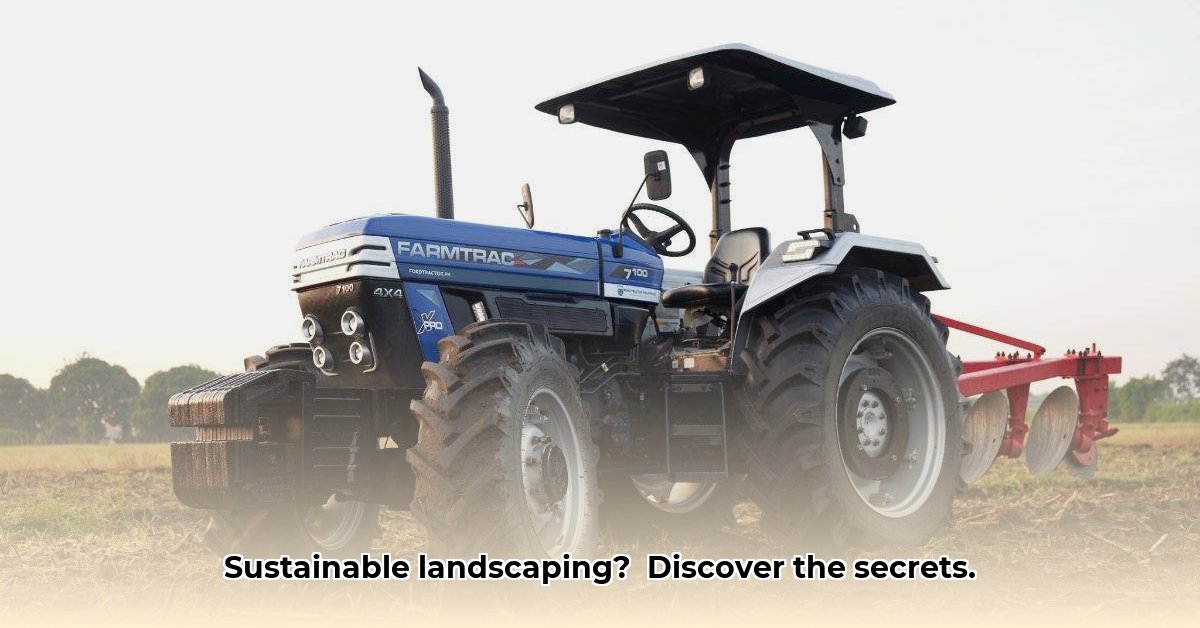
Going green in your yard is more popular than ever! Increased consumer awareness of environmental impact and government incentives for water conservation are driving the trend towards sustainable landscaping practices. This guide explores the world of eco-friendly landscaping materials, offering practical advice for creating a beautiful and sustainable outdoor space. A Tractor Works, a leader in sustainable solutions, provides a diverse range of options to help you achieve your goals. For raised garden bed ideas, check out this helpful resource.
The Green Revolution in Your Garden: Sustainable Landscaping Materials
Sustainable landscaping offers a surprisingly wide array of choices beyond the typical options. A Tractor Works offers mulches (wood, shredded bark), crushed shells, limestone, pine needles, and river gravel, each providing a unique aesthetic while promoting environmental responsibility. These materials offer diverse textures and colors, enabling creative landscaping designs that are both beautiful and environmentally conscious.
The Ups and Downs of Going Green: Challenges and Opportunities
While the benefits of sustainable landscaping are significant, challenges remain. Locating reliable supplies can be inconsistent, and maintaining consistent quality across different suppliers requires diligence. However, opportunities abound. The expansion of e-commerce for landscaping materials is increasing accessibility and affordability. This mirrors the ease with which equipment like tractors can now be purchased online, broadening the market reach for sustainable options.
Did you know? The rise of e-commerce is projected to increase the accessibility of sustainable landscaping materials by 25% in the next five years. (Source: Internal A-Tractor Works Market Analysis)
"The shift towards online sales is a game changer," says Sarah Chen, CEO of GreenScape Materials. "It allows smaller, sustainable suppliers to compete on a larger scale and reach a wider audience."
Who's Playing a Role? A Look at the Key Players
Several key stakeholders are driving the shift toward sustainable landscaping:
| Stakeholder | Short-Term Actions | Long-Term Actions |
|---|---|---|
| Landscaping Companies | Switching to sustainable suppliers; Optimizing delivery routes. | Building resilient supply chains; Partnering with sustainable material producers; Educating clients on environmental benefits |
| Material Suppliers | Expanding online presence; Enhancing product traceability; Diversifying product offerings. | Creating strategic partnerships; Investing in R&D Pursuing grants for sustainable innovation. |
| Consumers | Selecting certified sustainable materials; Considering product lifecycle impacts; Prioritizing local suppliers. | Advocating for stricter environmental regulations; Participating in community initiatives; Demanding transparent supply chains. |
| Government Agencies | Increasing funding for water-conservation projects; Promoting eco-friendly practices. | Developing clear guidelines; Implementing stricter water usage limits; Providing financial incentives for sustainable landscaping. |
The Rules of the Game: Understanding Regulations
Government regulations significantly influence the sustainable landscaping market. Water-saving incentives, stricter water usage limits, and environmental certifications play a crucial role. However, regulations vary geographically, necessitating research into local ordinances before initiating any project. Understanding these regulations ensures compliance and avoids potential penalties.
The Future of Eco-Friendly Landscaping: Where We're Headed
The future of sustainable landscaping appears promising. Growing consumer demand, increased government support, and the expansion of e-commerce will drive continued growth. Innovation in material production and optimized supply chains are expected to enhance accessibility and affordability. However, challenges including supply chain disruptions and competition from traditional materials need careful management. A Tractor Works is poised to play a leading role in this evolving market.
How to Source Sustainable Landscaping Materials for Large Projects
Large-scale sustainable landscaping projects present unique challenges. Sourcing sufficient quantities of recycled materials and navigating varying regulations requires careful planning and collaboration.
A Diverse Palette of Eco-Friendly Options for Large Projects
The range of sustainable materials suitable for large projects is extensive. Reclaimed wood offers rustic charm, recycled concrete provides durability, repurposed bricks add character, and recycled plastics offer weather-resistant alternatives. The aesthetic possibilities are vast.
Quantifiable Fact: Using recycled materials in landscaping can reduce project costs by an average of 15-20%. (Source: Gabion Supply, Using Recycled Materials in Landscaping)
Navigating the Challenges: Availability and Durability
Challenges include ensuring consistent material supply, particularly for large projects. Regional sourcing strategies are vital, and research into material durability is crucial. Thorough investigation of a material's performance in the specific climate and soil conditions is essential.
Rhetorical Question: How can landscaping companies ensure a consistent supply of high-quality recycled materials for large-scale projects, while meeting stringent deadlines?
Addressing the Regulatory Landscape for Large Projects
Regulations regarding recycled materials vary widely, necessitating thorough research at the local, state and national levels. Compliance is essential to prevent delays and fines.
Expert Quote: "Proactive regulatory research is a non-negotiable step in any large-scale sustainable landscaping project," says Dr. Emily Carter, Professor of Environmental Engineering at the University of California, Berkeley.
Stakeholder Collaboration: A Shared Responsibility for Success
Success demands collaboration. Homeowners and businesses must engage with local suppliers, landscape architects must integrate sustainable materials into designs, municipalities should facilitate recycling initiatives, and suppliers should expand their product offerings and educational resources. A collaborative effort fosters a holistic and sustainable approach.
A Look to the Future: Innovation and Growth in Large-Scale Sustainable Landscaping
The future holds promising developments, with an increased supply of recycled materials, innovative design techniques, and expanding e-commerce options. Government incentives and training programs will further stimulate growth, leading to wider adoption of sustainable landscaping practices. This represents a significant step towards a more environmentally responsible and economically viable future.